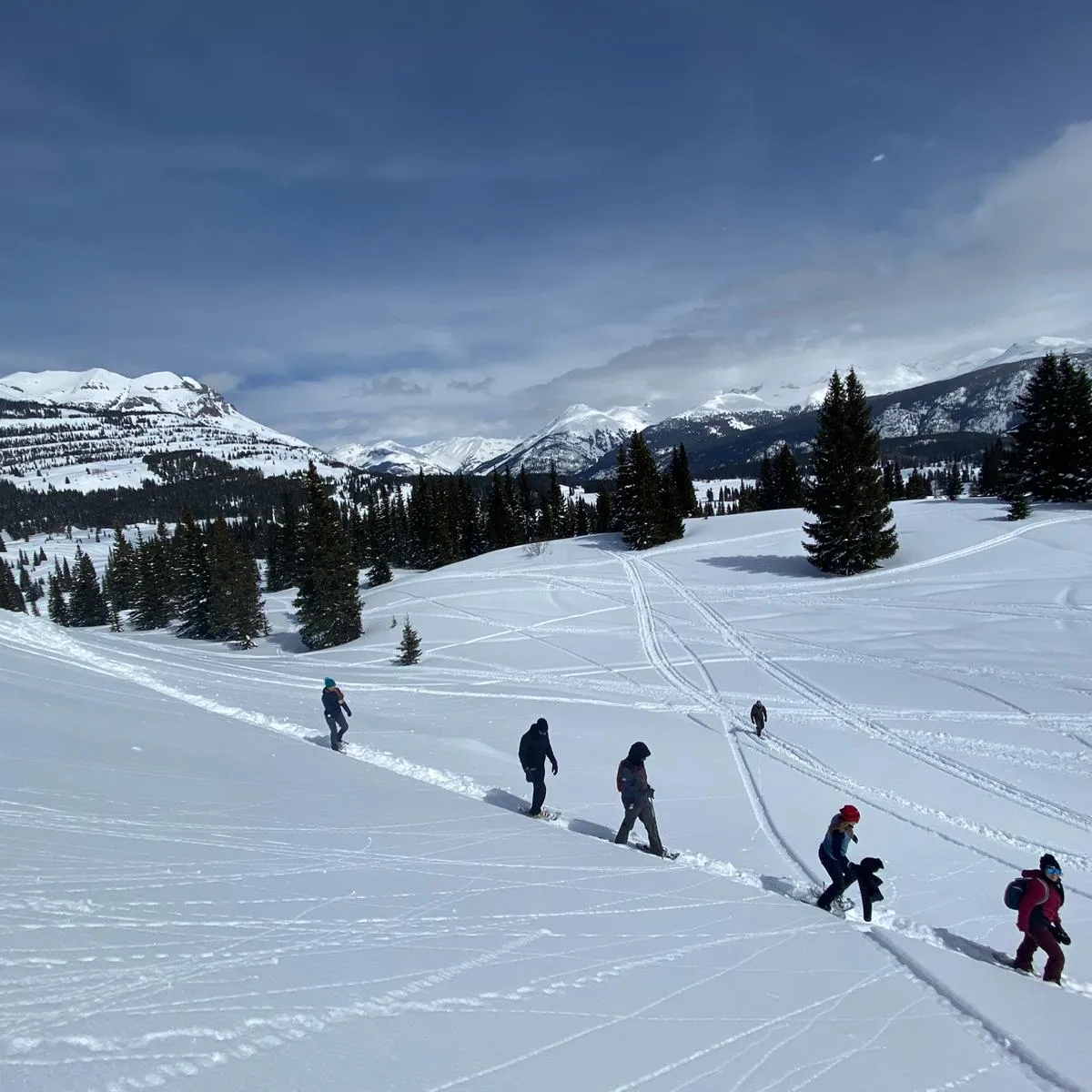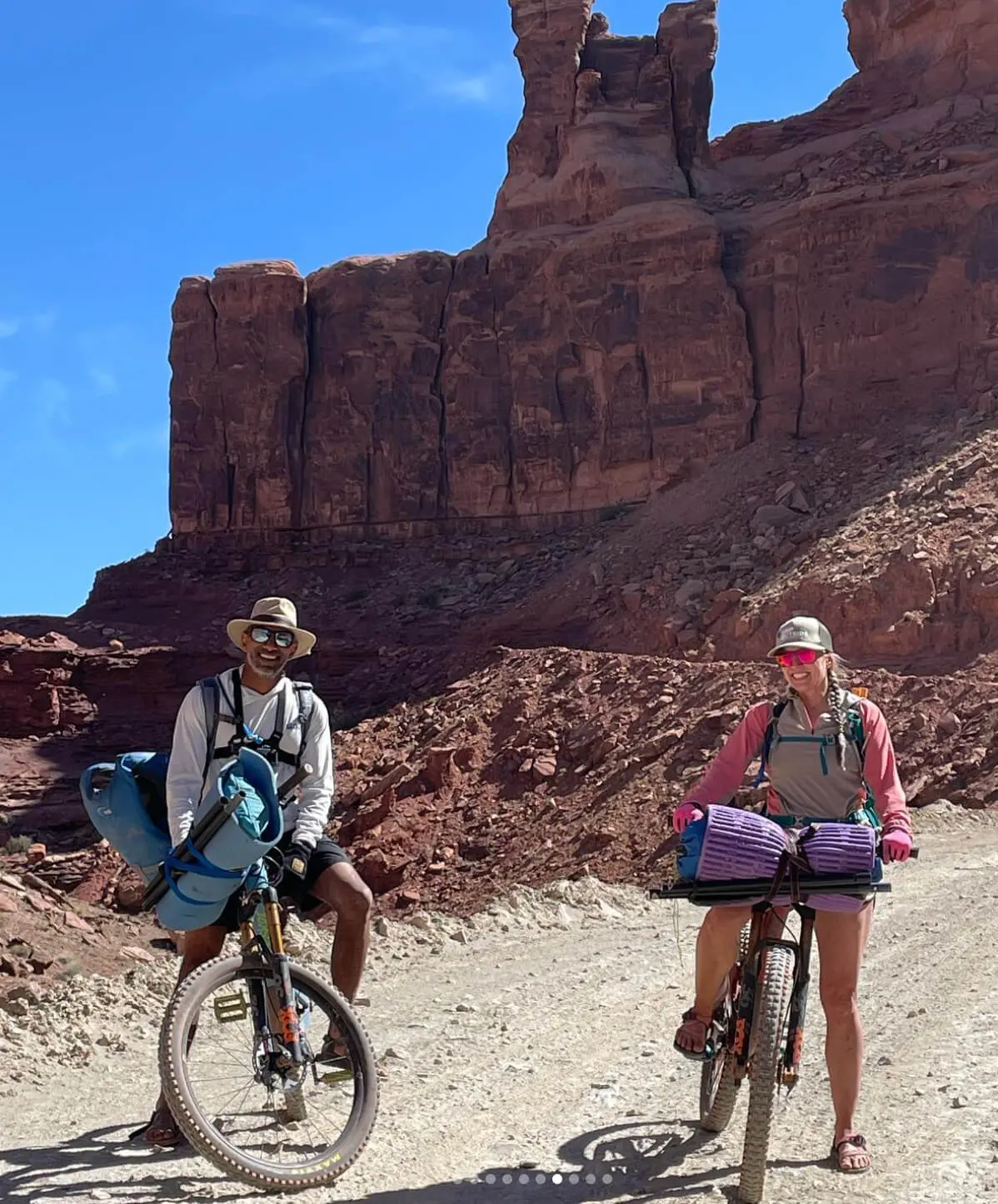Snowshoeing Guide for Beginners
Are you curious about snowshoeing but don’t know where to start? Don’t worry; it’s simpler than you might think. In this guide, we’ll cover the basics of snowshoeing, the fun factor, how it compares to hiking, its benefits, difficulty level, calorie burning, how it stacks up against cross country skiing, and even tips for snowshoeing with your furry friends.
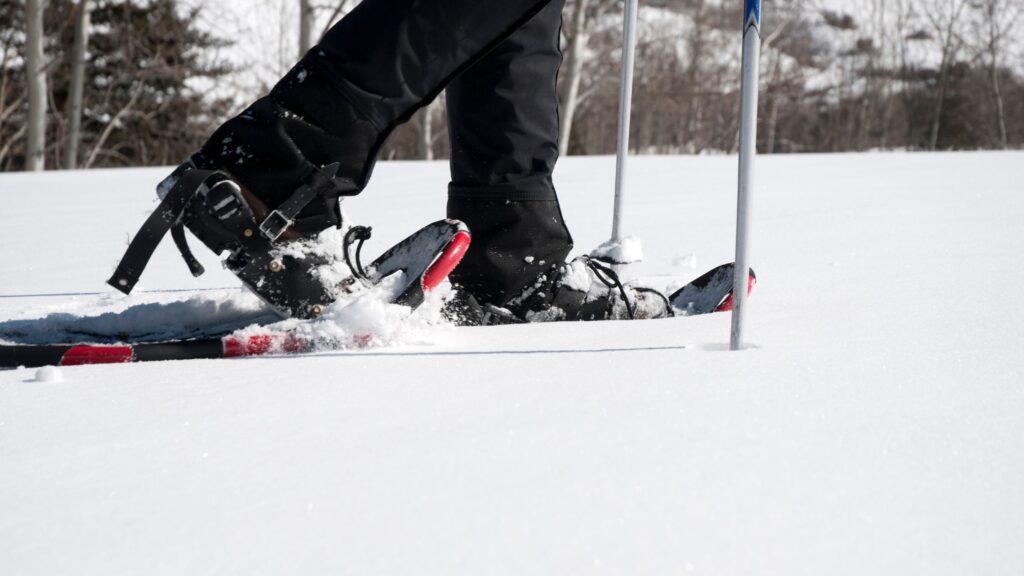
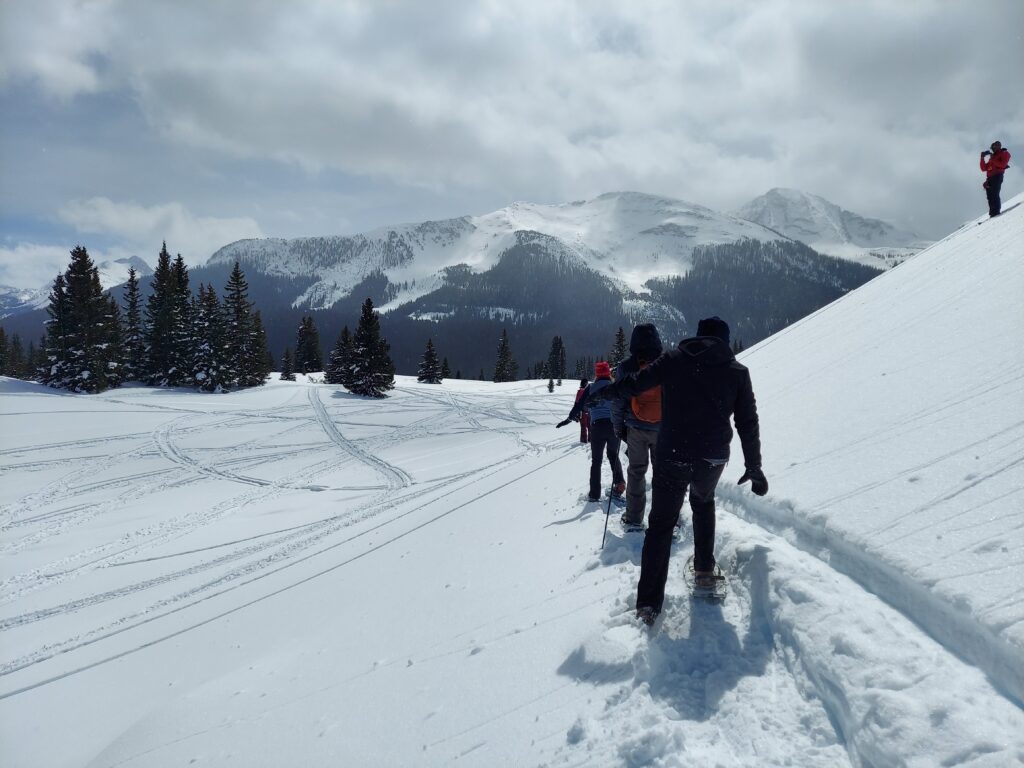
How to Snowshoe
Snowshoeing is like walking with big, flat shoes that keep you from sinking in the snow. Here’s how to get started:
- Strap on the snowshoes over your regular winter boots.
- Take normal steps; the snowshoes will help you stay on top of the snow.
That’s it! You’re snowshoeing.
Most people who try it think that snowshoeing is a blast! You get to experience winter in a whole new way. Plus, you can do it with friends or family, making it even more enjoyable.
Snowshoeing vs. Hiking
Snowshoeing is like hiking in the snow. You can explore outside in winter without sinking into deep snowdrifts (aka post-holing). It’s a bit slower, but it’s a cool way to enjoy the outdoors in winter, and get a workout!
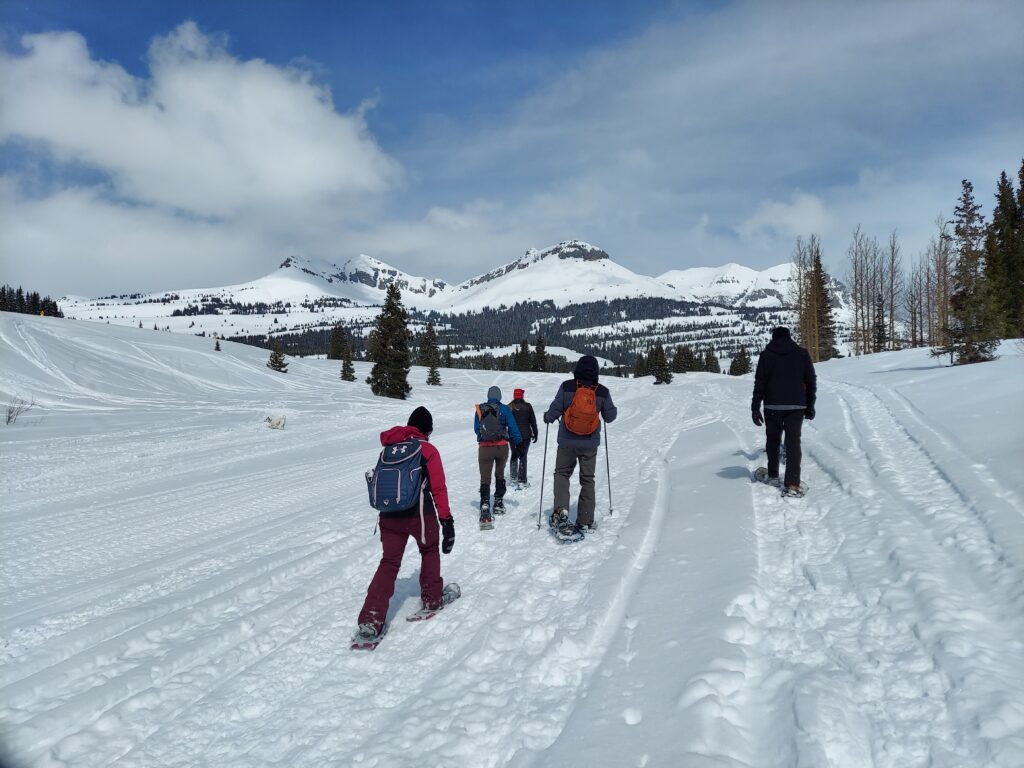
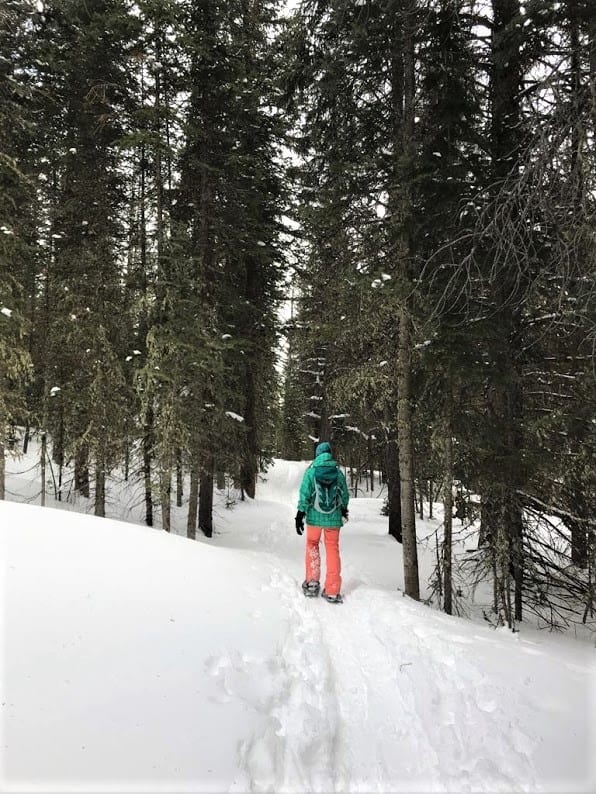
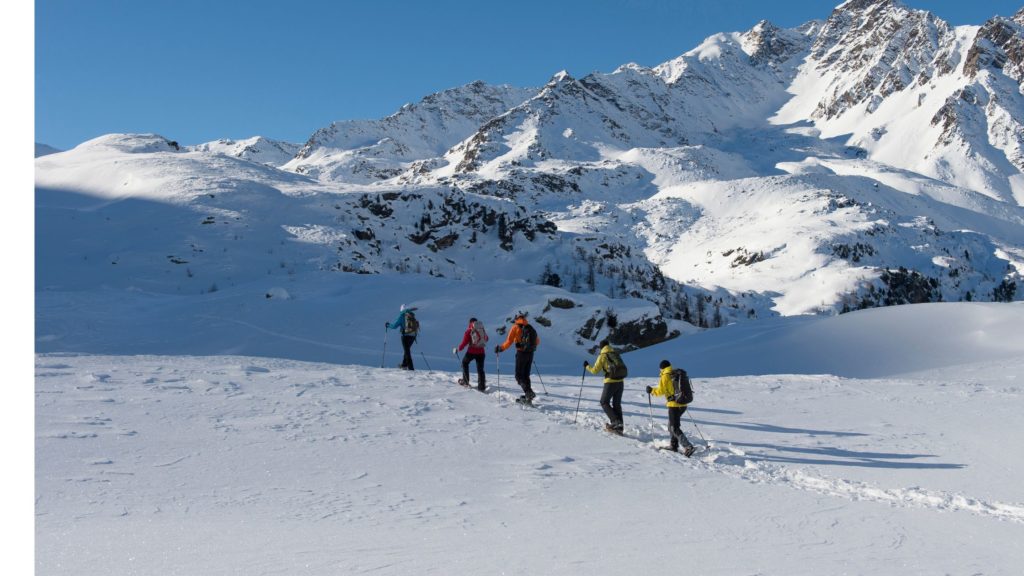
Benefits of Snowshoeing
Not only is snowshoeing fun, but it has many other benefits!
- Snowshoeing is a great workout that’s considered low impact and is gentle on joints, like your knees.
- You can go snowshoeing anywhere there’s snow.
- Snowshoeing is an excellent way to enjoy winter, and a great way to warm up.
- You don’t need a lot of expensive gear (or any expensive gear).
- It’s free in many places, or very inexpensive! Snowshoes only cost around $10-25 per day to rent.
How Hard Is Snowshoeing
Snowshoeing is pretty easy, even for beginners. If you can walk, you can snowshoe. This makes snowshoeing accessible to people of all ages and fitness levels. The hardest part of snowshoeing technique might be getting used to the feeling of having bigger feet. Like hiking, starting out on a flat trail will make snowshoeing easier, and trails with more elevation changes will provide more of a challenge. Snowshoeing may be more challenging after a heavy snowfall, and the first snowshoers to break the trail will usually do more work!
Snowshoeing is inclusive, suitable for beginners and seasoned adventurers alike. You can choose trails that match your fitness level, from gentle, flat paths to more challenging terrain with elevation gain. The best part is that you don’t need to invest in expensive or specialized gear, as snowshoes are readily available for rent and purchase. It’s a cost-effective way to enjoy the beauty of winter.
Snowshoeing is a great activity to consider when you want to take a break from skiing or snowboarding during a ski trip (it can be exhausting to ski 5 days straight!), or when you are looking for an adventure where you can take in the scenery and relax a bit more.
How Much Snow is Needed to Snowshoe
You can usually go snowshoeing with as little as 4 to 6 inches (10 to 15 cm) of snow, although the best conditions are typically around 8 to 12 inches (20 to 30 cm) of fresh, powdery snow. The amount of snow required depends on various factors, including the type of terrain and the weight of the snowshoer. If the snow isn’t fresh, it may be packed down already by other snowshoers, skiers and hikers so you may not need snowshoes and might be able to hike in just your boots. We recommend checking local trail reports and snow conditions before heading out on your snowshoeing adventure.
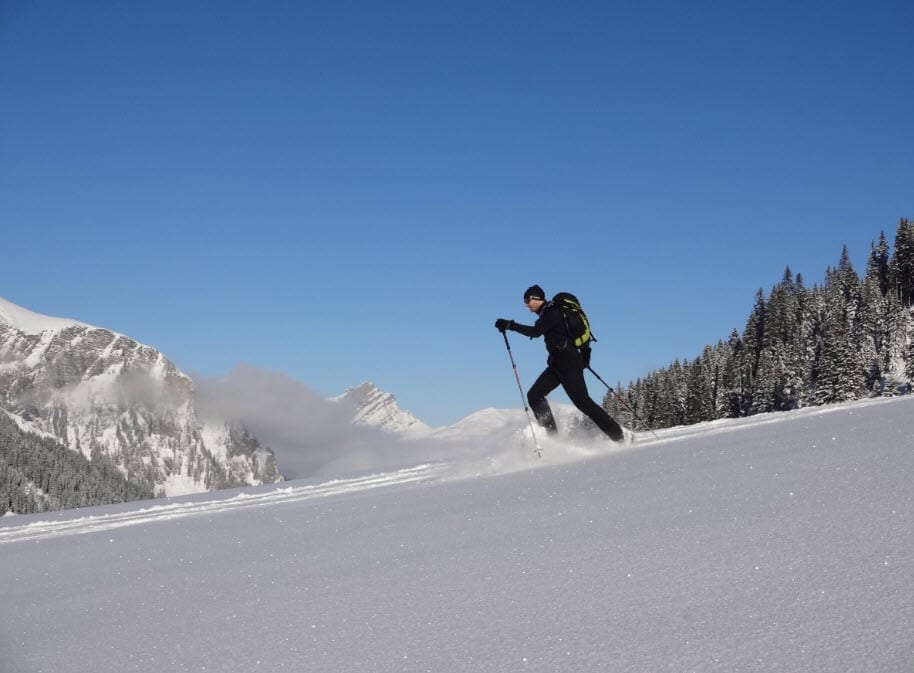
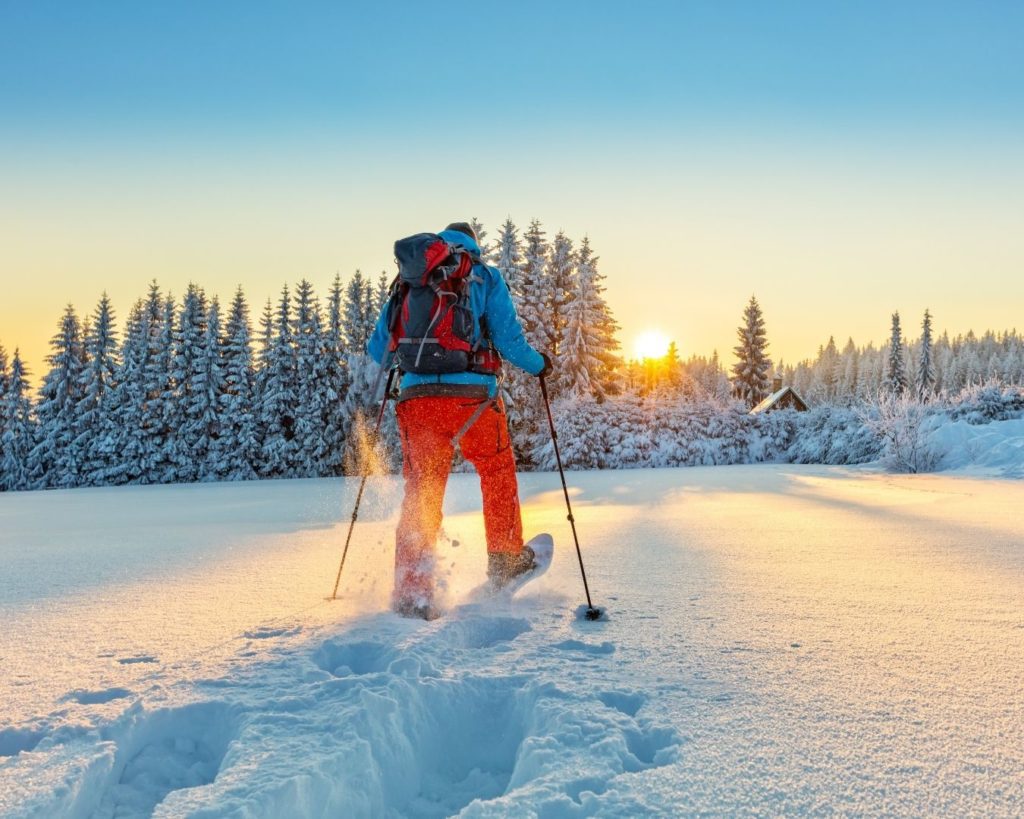

Calories Burned Snowshoeing
Snowshoeing burns a lot of calories, about the same as hiking or cross-country skiing. The number of calories burned while snowshoeing depends on factors like your weight, the intensity, and the terrain you cover. Here’s a rough estimate:
- Gentle and easy snowshoeing: If you’re taking a gentle stroll on flat terrain, you can expect to burn approximately 300-400 calories per hour. This is comparable to a brisk walk.
- Moderate snowshoeing: If you’re moving at a moderate pace on varied terrain with some elevation changes, you may burn around 400-600 calories per hour. This level of effort is similar to a light to moderate hike.
- Challenging snowshoeing with elevation gains: When you tackle more demanding trails with steep inclines and more challenging terrain, you can burn upwards of 600-800 calories or more per hour. This is similar to the calorie expenditure during a moderate to high intensity hike or cross-country skiing.
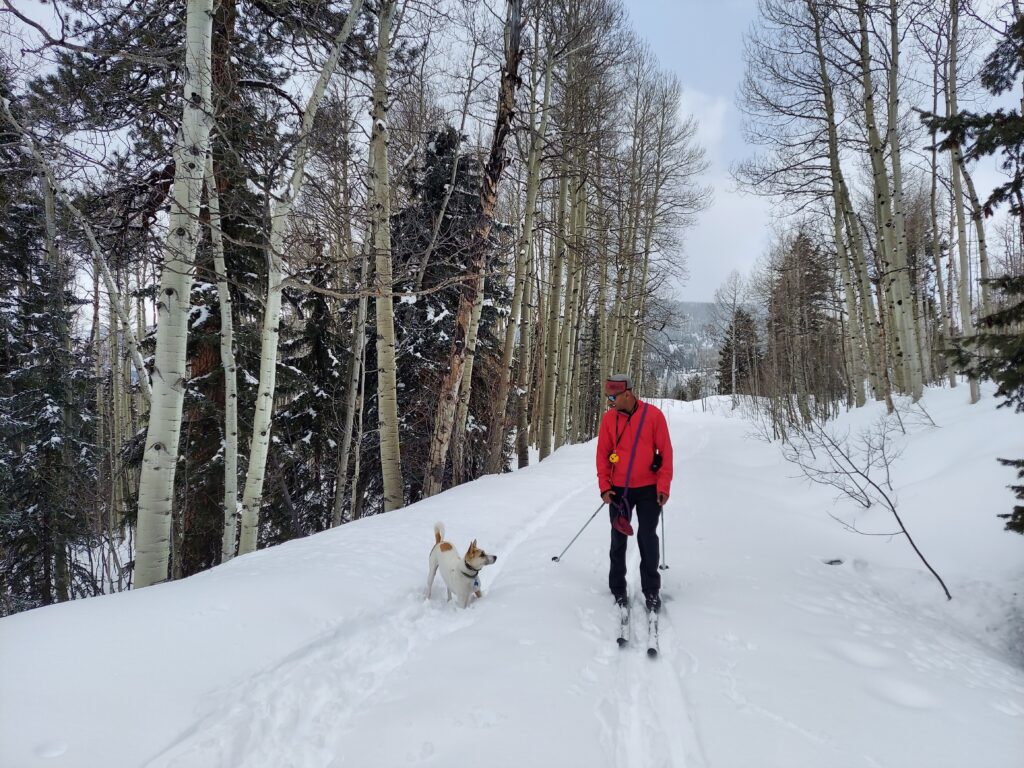
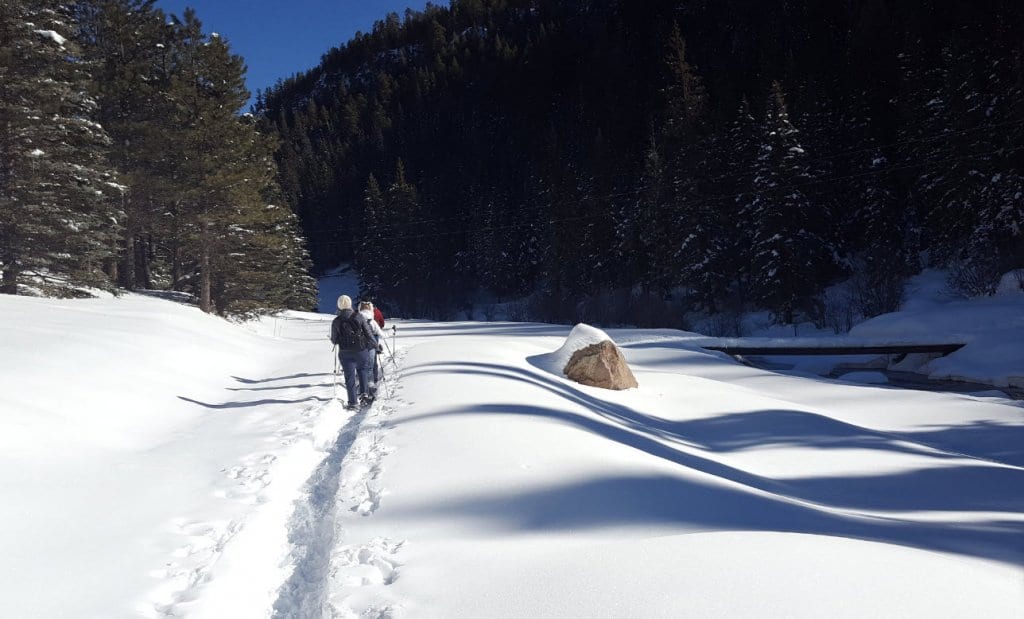
Snowshoeing vs. Cross Country Skiing
Snowshoeing and cross-country skiing offer distinct winter adventures, each with its own appeal. Snowshoeing is simple to pick up – you don’t need special skills or lots of practice. Cross-country skiing, however, requires mastering a gliding technique that can be a bit more challenging for newcomers. If you’re all about simplicity and hitting the trails right away, snowshoeing is your go-to. You’ll need just snowshoes and winter boots, while cross-country skiing requires skis, poles, bindings, and ski boots, making it a bit more gear-intensive.
When it comes to the workout, the choice between the two depends on your preference. Snowshoeing mainly engages your legs, offering a good lower body workout. Cross-country skiing, on the other hand, involves your entire body, including your arms and core, for a more comprehensive workout. If speed is your game, cross-country skiing can be faster on flat, groomed trails. However, snowshoeing shines when it comes to exploring off-trail or uneven terrain, thanks to the broad surface area of the snowshoes that helps distribute your weight and keeps you on top of the snow.
What Size Snowshoes
Snowshoe sizing depends primarily on your body weight, with additional considerations for the type of terrain and snow conditions. Most manufacturers provide weight recommendations and size charts for their snowshoes, helping you match your weight to the right size. Snowshoe outfitters will also make sure that the snowshoes you rent are fitted to your size and where you will be going.
It’s important to select snowshoes that can securely fit your winter boots, and trying them on is recommended, especially if you’re between weight categories or have specific preferences. Proper snowshoe sizing ensures better comfort and maneuverability during your winter adventures.
Check out our comprehensive What to Wear Snowshoeing guide for clothing, footwear and gear recommendations.
Poles for Snowshoeing
Poles are not an absolute necessity for snowshoeing, but they can be beneficial and provide added stability, balance, and efficiency, particularly in certain situations. If you use poles for hiking, you may want them for snowshoeing as well.
Benefits of Snowshoeing Poles:
- Stability: Poles can provide extra stability, especially when navigating uneven or steep terrain. They help you maintain balance and prevent slips and falls.
- Ascents and Descents: When ascending hills or steep inclines, poles can assist in distributing your weight and provide leverage, making the ascent easier and less strenuous. Poles can also be handy when descending slopes. They provide additional support and can help control your speed and balance during descents.
- Reducing Impact: Poles can reduce the impact on your knees and joints by absorbing some of the shock when you plant them in the snow.
- Extra Support: For those who may have balance issues or knee problems, poles can offer extra support and confidence on the trails.
When Poles May Not Be Necessary:
- Flat Terrain: On relatively flat and groomed trails, where balance and stability are less of a concern, poles may not be essential.
- Personal Preference: Whether to use poles ultimately depends on personal preference. Some snowshoers enjoy the added support that poles provide, while others prefer the simplicity of snowshoeing without them.
- Casual Snowshoers: If you’re engaging in casual snowshoeing for leisure and don’t plan on tackling challenging terrain, you may not need poles.
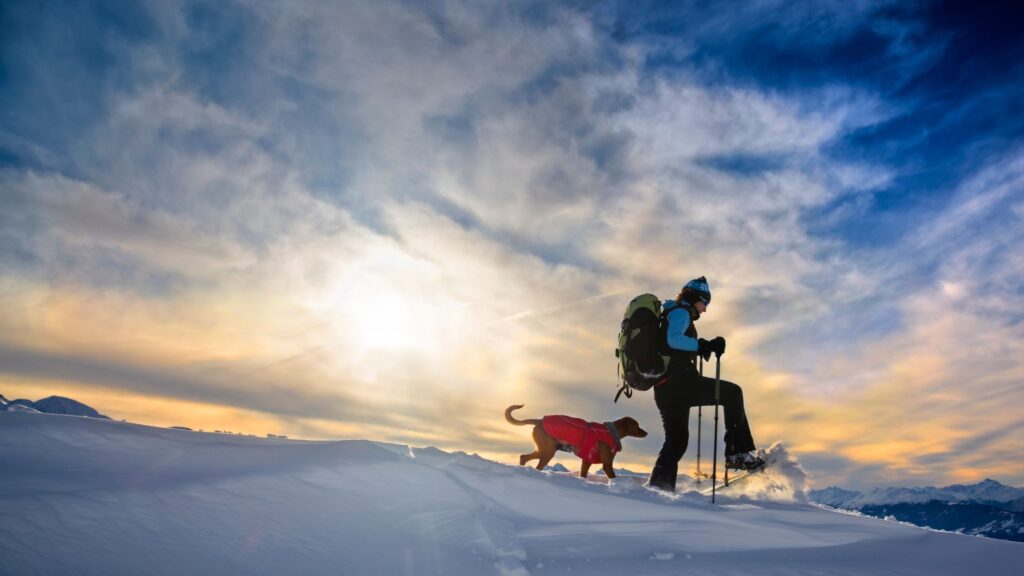
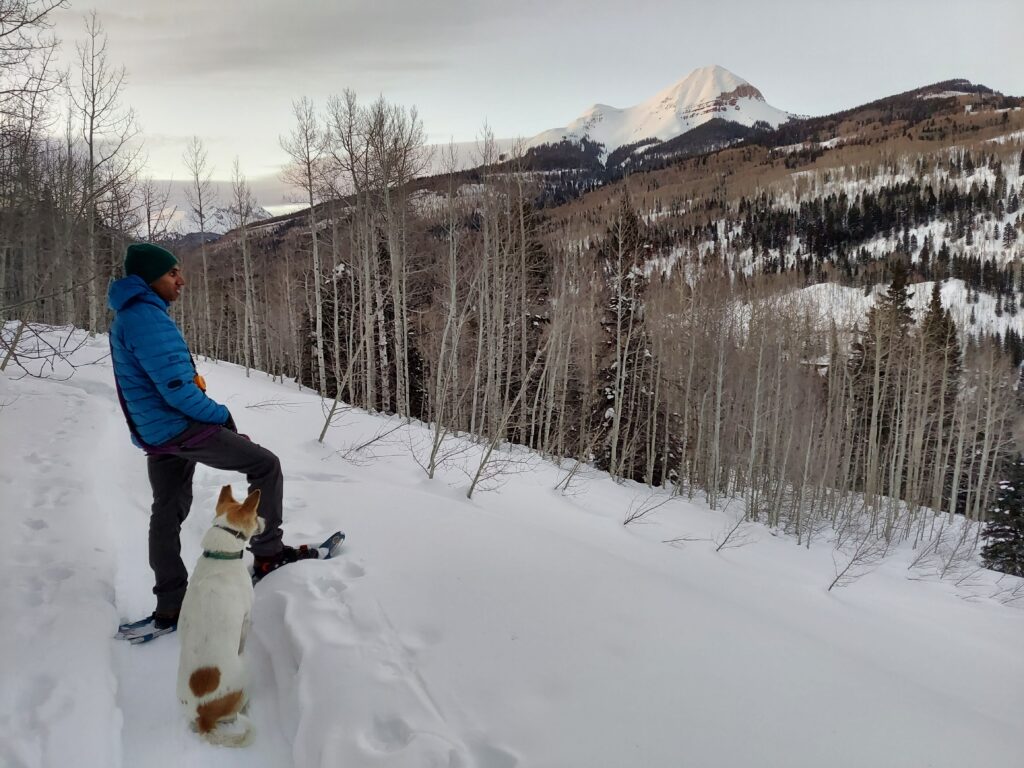
Snowshoeing with Dogs
If you have a furry companion, snowshoeing with them is a blast. Just make sure your pup is comfortable in the snow and has some doggy booties or paw salve to protect their paws if they aren’t used to the snow.
Here are some tips for an enjoyable snowshoeing adventure with your dog:
- Check the Dog’s Fitness: Before hitting the trails make sure your dog is physically fit for the activity. If your dog is elderly, has joint issues, or isn’t used to strenuous exercise, consult your veterinarian to ensure snowshoeing is ok for them.
- Proper Gear: Invest in cold weather gear for your dog, including doggy booties to protect their paws from the cold. Ruffwear makes some great dog booties that will last! Or try Musher’s Secret, a paw salve that forms a barrier on their paws to help protect them from the elements. A doggy coat can also help keep them warm, especially in frigid temperatures.
- Leash and Control: Always keep your dog on a leash unless you are in an area where off-leash is allowed. This ensures their safety and the safety of other trail users. Train your dog to obey basic commands like “stay,” “come,” and “leave it” before attempting off-leash activities. Make sure your dog is well-socialized and comfortable around other people, dogs, and wildlife. Unpredictable behavior can be stressful for both you and your pet on the trail.
- Stay Hydrated: Just like you, your dog needs hydration. Carry enough water and a collapsible bowl for them. Snow can be deceptively dehydrating, and your dog might need more water than you expect.
- Know the Rules: Familiarize yourself with the specific rules and regulations for snowshoeing with dogs in your chosen area. Some trails may have restrictions or seasonal closures to protect wildlife.
- Pick Up After Your Dog: Always bring waste bags and pick up after your dog. It’s essential to be a responsible pet owner and leave no trace.
- Be Mindful of Wildlife: Keep an eye out for wildlife and keep your dog at a safe distance. Wildlife encounters can be unpredictable, and it’s crucial to respect their space.
- Cold Weather Considerations: In extremely cold weather, limit the time your dog spends outdoors, as their paws, ears, and nose can be susceptible to frostbite. Ensure they have a warm place to rest and recover after the outing.
Snowshoeing with your dog is not only about exercise but also about enjoying nature together. Take breaks, play in the snow, and capture those memorable moments on your adventure.
Additional Snowshoeing Safety Tips
- Safety first! Check the weather and trail conditions before heading out, and let someone know your plans.
- If you are traveling or unfamiliar with the area, check with a local outfitter or guide on the best trail for your level and ability, and understand weather, snow and avalanche conditions. Get a paper map to bring along or download the trail map on your phone. There may not always be an obvious trail, which makes trail navigation important.
- Consider carrying an emergency device like a Garmin In-Reach or SPOT messenger – especially if you will be in an area with limited cell service.
Leave No Trace Snowshoeing
Always ensure that you are following Leave No Trace principles during your outdoor adventures. Snowshoeing is no exception! Planning ahead and preparing for weather, avalanche risk and more, staying on designated trails and established routes, packing out all trash and waste (including human waste!), and respecting wildlife are all critical for minimizing your impact on the environment. Practicing responsible outdoor ethics helps preserve these natural spaces for future generations to enjoy.
So, strap on those snowshoes, head outside, and enjoy the snowy wonderland!

